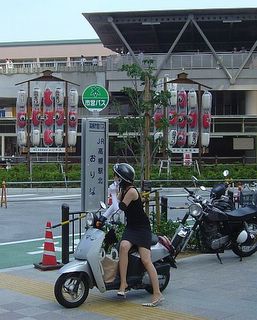
(Scooters are high-syle in Japan) 
asahi.com:Sleek scooters for the slouch generation – ENGLISH: “Sleek scooters for the slouch generation
04/30/2005
By LOUIS TEMPLADO Staff Writer
There’s only so much you can do with an engine and a pair of wheels. Anyway you put them together the result is pretty much going to be a motorcycle. It’s a machine, true, but also a statement of style, the basic outline of which has hardly changed in the past century.
Yet, there’s a fresh breeze in the world of two-wheel transport, and nowhere is that more evident than on young fashion’s frontline-the back streets of Tokyo’s Harajuku district. The area has always been a fashion runway, but these days “Cat Street”-as the paved-over Shibuya River is now called-is looking more and more like a bike showroom. On any given weekday sleek, low-slung scooters practically line the length of the promenade, while engine growls fill the air.
Forget the grandma’s little runner: These machines taking up the sidewalk are big-engined beasts with big-barrel names to match: Majesty, Grand Majesty and Maxam (all by Yamaha Motor Co.) and the Forza and slightly effete-sounding Fusion, by Honda Motor Co. In this part of town, they are the ultimate fashion accessory.
It may not seem like it, but fewer and fewer motorcycles are bought in Japan every year.
Some 700,000 two-wheel vehicles were sold last year, a 7.9 percent drop from the previous year. Sales of large scooters, however, have been on a steady rise.
About 97,000 scooters with engines in the 126cc to 250cc class, were bought last year, a rise of 10.5 percent compared with the year before. It may seem a small figure, but profit-wise the sale of one big scooter equals the sale of five to ten smaller ones, according to industry experts.
The new scooters have much to recommend them. They can purr along at faster than 100 kilometers per hour, keeping up with traffic even on the freeway.
They don’t demand fiddly foot and wrist coordination-the scooters are automatic and come with anti-lock braking systems and even satellite navigation screens as options. Their displacement is small enough to exempt them from expensive inspection checks required every two years. (There are supersize scooters though that require them).
Also alluring is a loosening of the road law to allow bikes with passengers on national highways from April 1, as well as a new license class for automatic bikes set to be issued in June.
But the real reason for the sales spike is that scooters have come into cool.
“I wouldn’t ride anything else but a scooter,” says Takayuki Yamazaki, spotted in Harajuku in fake fur and sunglasses atop a black Honda Fusion. “I am interested in design and I really like the silhouette. My theme is `low and long.”’
A standard Fusion goes for upward of 550,000 yen, but Yamazaki also spent an additional 300,000 yen on lowering the chassis even further, in addition to other customizations. A quick area check reveals that most of the big scooters have been customized one way or another.
The big bike makers have set up listening posts in the trendsetter area. Yamaha runs a cafe, while Honda operates a shop right on Cat Street, just behind the Chanel building, called H-Free.
Inside there are bikes but it’s actually a clothing store. The staff, according to manager Mabito Hatanaka, are actually young Honda researchers and designers “pretending to be salespeople.”
“We don’t just research machines,” explains Hatanaka, who himself is a chief engineer at Honda’s Asaka R&D Center in Saitama Prefecture. “In order for us to fit our products into people’s lives we also need to research trends and street culture.”
Big scooters are not actually new, according to Hatanaka, who notes that Honda’s Fusion has been on the market for about 20 years. The Fusion was a bit of an oddity when it came out, and appealed mostly to a gray-haired set for whom they really were granny scooters.
The fact that it was easy to get on and off was a selling point.
Yamaha was the first to appeal to young riders and took the sales lead with its Majesty of 1995. In what’s now known as the YH (Yamaha vs. Honda) War, Honda took it back with the help of its Forza, to which Yamaha then responded with a Majesty redesign, the Grand Majesty and now the Maxam.
“Big scooters reached boom status about five years ago,” says Hatanaka, “when people started looking at them as an extension of fashion. Scooters are part of a total look.”
Dolphinlike, the scooters seem the perfect vehicle for Harajuku’s distinct pose-a studied slouch meant to connote effortless cool.
“A motorcycle forces you into a certain riding position; you have to tense up to ride. But on a scooter, you can just hang loose and relax,”says Hatanaka.
For that reason the venerable Fusion, rather than newer and better-selling Majesty and Forza models, is king of the hill in Harajuku. Twenty years on, it’s still the lowest scooter out there, with the rear seat nearly as low as the driver’s-important for the girlfriend factor.
As for snob appeal-the Fusion offers a conception of the far future from the near past-says Hatanaka. And how cool is that?
Taro, 21, and Maru-kun, 20, seen riding around the area on a recent Sunday on twin Majesties, seemed unconvinced.
“The Majesty’s cooler,” says Taro. “Much,” agrees his partner.
And what exactly makes it cool?
“That’s easy,” says Maru-kun. “When you ride one, it feels like summer.”(IHT/Asahi: April 30,2005)















Sat, Apr 30, 2005
News